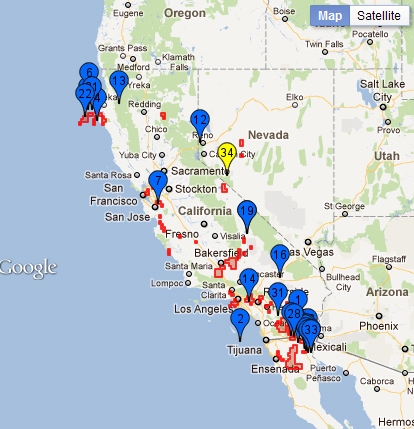Written by Alan Buis
Jet Propulsion Laboratory
 Pasadena, CA – While earthquakes can’t yet be predicted, scientists are making advances in their ability to forecast where they are most likely to occur, with the best forecasts now about 10 times more accurate than a random prediction, according to a new study by scientists at the University of California, Davis.
Pasadena, CA – While earthquakes can’t yet be predicted, scientists are making advances in their ability to forecast where they are most likely to occur, with the best forecasts now about 10 times more accurate than a random prediction, according to a new study by scientists at the University of California, Davis.
The researchers compared seven earthquake forecasts submitted to a competition organized by the Southern California Earthquake Center in 2005.
Among the competitors was a NASA-funded forecast developed by a UC Davis-led group under NASA’s QuakeSim program. Results of the study will be used to help researchers develop better quake forecasts and improve the tools they use to assess them.
The teams were invited to forecast the probability of an earthquake of magnitude 4.95 or greater occurring during the period from January 1st, 2006 through December 31st, 2010 in California and bordering areas. The region included in the competition was divided into approximately 8,000 grid squares. During the competition timeframe, 31 earthquakes of magnitude 4.95 or greater struck this region in 22 different grid areas.

While all the forecasts showed some success in forecasting the locations of likely earthquakes, the NASA-funded UC Davis forecast team, which included Andrea Donnellan of NASA’s Jet Propulsion Laboratory, Pasadena, CA, was found to be the most accurate at picking the quake locations. It correctly labeled 17 of the 22 affected grids, and gave the highest probability of an earthquake in eight of these 17.
“These forecasts are helping guide our data collection efforts by focusing our attention on regions with higher earthquake probability,” said Donnellan. “This approach worked well for capturing the motions of the 2010 magnitude 7.2 El Mayor-Cucupah earthquake in Mexico’s Baja California using NASA’s Uninhabited Aerial Vehicle Synthetic Aperture Radar.”
Study results were published September 26th in the Proceedings of the National Academy of Sciences.
For more information on the study, visit: http://www.news.ucdavis.edu/search/news_detail.lasso?id=10025 .
For more information on QuakeSim, visit: http://quakesim.org/ .
JPL is a division of the California Institute of Technology in Pasadena.


